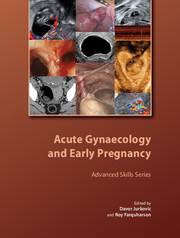Book contents
- Frontmatter
- Contents
- About the authors
- Acknowledgements
- Abbreviations
- Preface
- 1 Organisation and delivery of emergency care in early pregnancy and acute gynaecology
- 2 Epidemiology and aetiology of miscarriage and ectopic pregnancy
- 3 Diagnosis of miscarriage
- 4 Conservative and surgical management of miscarriage
- 5 Management of hyperemesis gravidarum
- 6 Diagnosis and treatment of recurrent miscarriage
- 7 Differential diagnosis and management of molar pregnancy
- 8 Drugs in early pregnancy
- 9 Diagnosis of tubal ectopic pregnancy
- 10 Conservative management of tubal ectopic pregnancy
- 11 Surgical management of tubal ectopic pregnancy
- 12 Diagnosis and management of non-tubal ectopic pregnancy
- 13 Diagnosis and management of acute pelvic pain
- 14 Management of vaginal bleeding in the acute clinical setting
- 15 Current concepts in screening and outpatient management of pelvic inflammatory disease
- 16 Diagnosis and management of haemorrhagic and septic shock
- 17 Role of minimally invasive surgery in acute gynaecology
- Index
13 - Diagnosis and management of acute pelvic pain
Published online by Cambridge University Press: 05 July 2014
- Frontmatter
- Contents
- About the authors
- Acknowledgements
- Abbreviations
- Preface
- 1 Organisation and delivery of emergency care in early pregnancy and acute gynaecology
- 2 Epidemiology and aetiology of miscarriage and ectopic pregnancy
- 3 Diagnosis of miscarriage
- 4 Conservative and surgical management of miscarriage
- 5 Management of hyperemesis gravidarum
- 6 Diagnosis and treatment of recurrent miscarriage
- 7 Differential diagnosis and management of molar pregnancy
- 8 Drugs in early pregnancy
- 9 Diagnosis of tubal ectopic pregnancy
- 10 Conservative management of tubal ectopic pregnancy
- 11 Surgical management of tubal ectopic pregnancy
- 12 Diagnosis and management of non-tubal ectopic pregnancy
- 13 Diagnosis and management of acute pelvic pain
- 14 Management of vaginal bleeding in the acute clinical setting
- 15 Current concepts in screening and outpatient management of pelvic inflammatory disease
- 16 Diagnosis and management of haemorrhagic and septic shock
- 17 Role of minimally invasive surgery in acute gynaecology
- Index
Summary
Introduction
Acute pelvic pain is usually defined as pain of less than 2 weeks’ duration. While this chapter focuses on the common gynaecological conditions that cause acute pain, it should be borne in mind that a woman may suffer an acute exacerbation of a chronic condition that may or may not have been previously diagnosed. Therefore, in some women the cause of the acute pain will be a condition typically associated with chronic pelvic pain. This chapter primarily describes the clinical approach to the management of acute pelvic pain rather than providing detailed descriptions of separate pathological entities causing pain. The emphasis is on clinical presentation and differential diagnosis of pelvic pain, with plenty of practical advice.
History and clinical examination
Taking a detailed history is one of the most important elements of the clinical assessment of a woman presenting with acute pelvic pain. Even if you are not the first person to see the woman and her history has already been taken by a colleague, it is always worth hearing the woman describe the onset and character of the pain again in her own words. The uterus, cervix and adnexa share the same visceral innervation as the lower ileum, sigmoid colon and rectum. Afferent pain signals travel via the sympathetic nerves to spinal cord segments T10 to L1. Because of this shared pathway, distinguishing between pain of gynaecological origin and pain of gastrointestinal origin is often difficult.
- Type
- Chapter
- Information
- Acute Gynaecology and Early Pregnancy , pp. 169 - 180Publisher: Cambridge University PressPrint publication year: 2011



